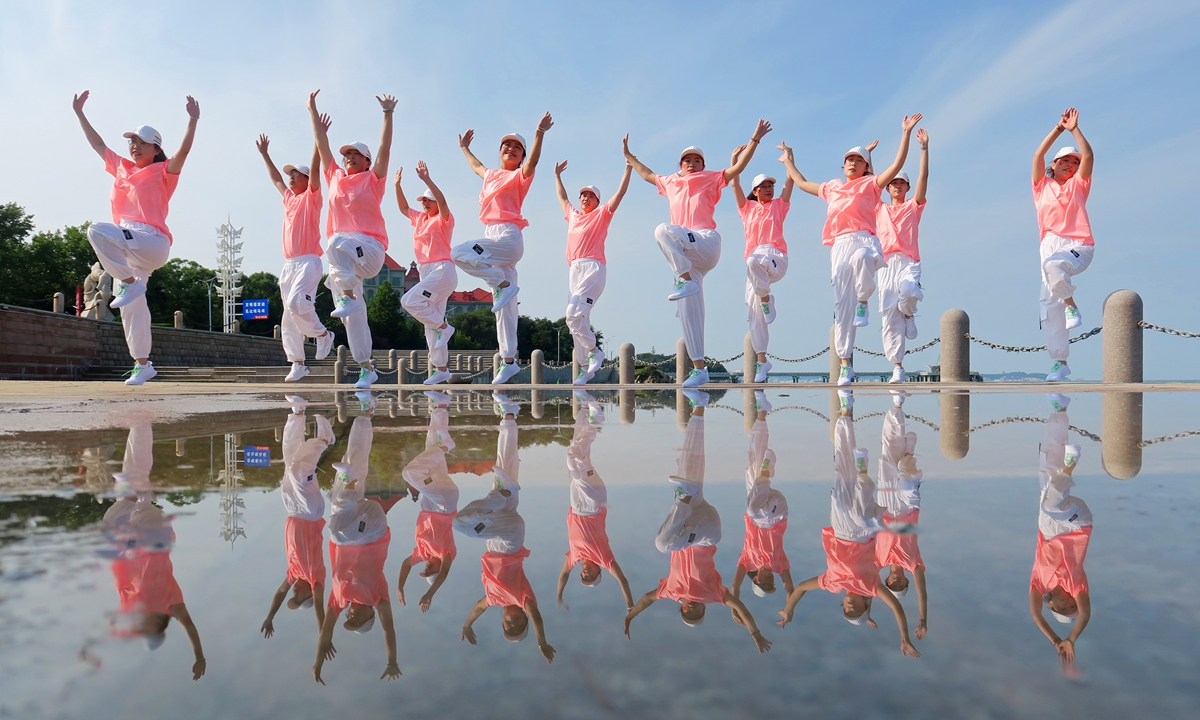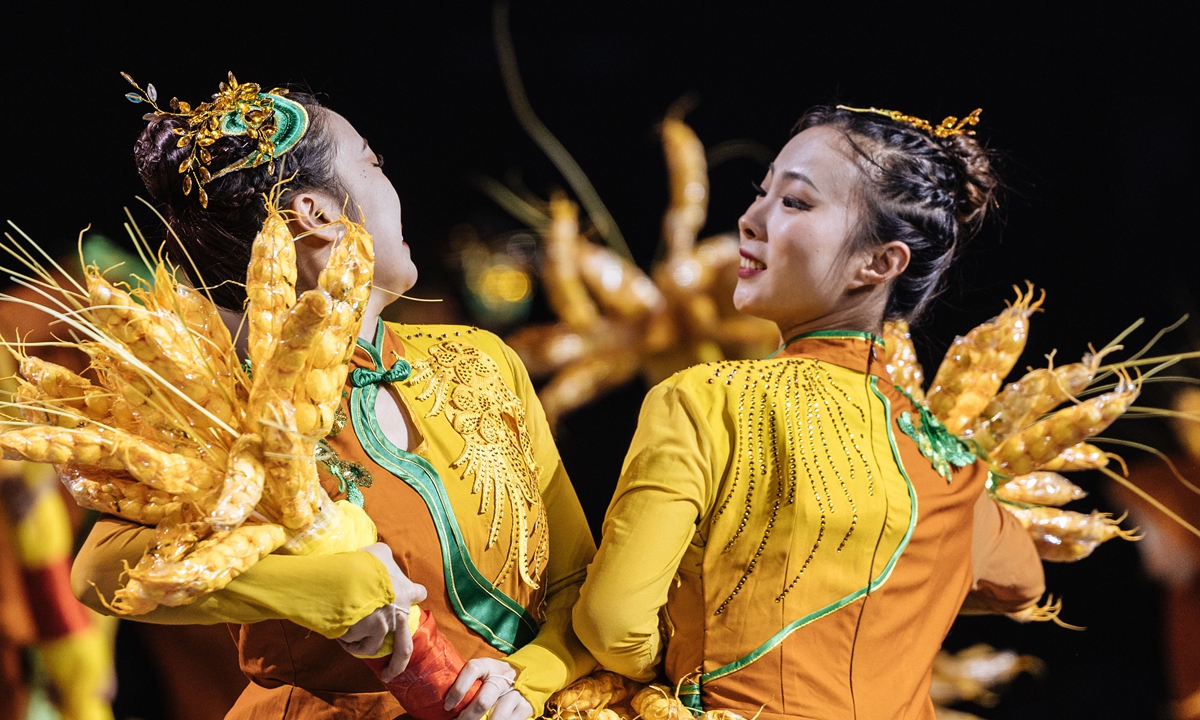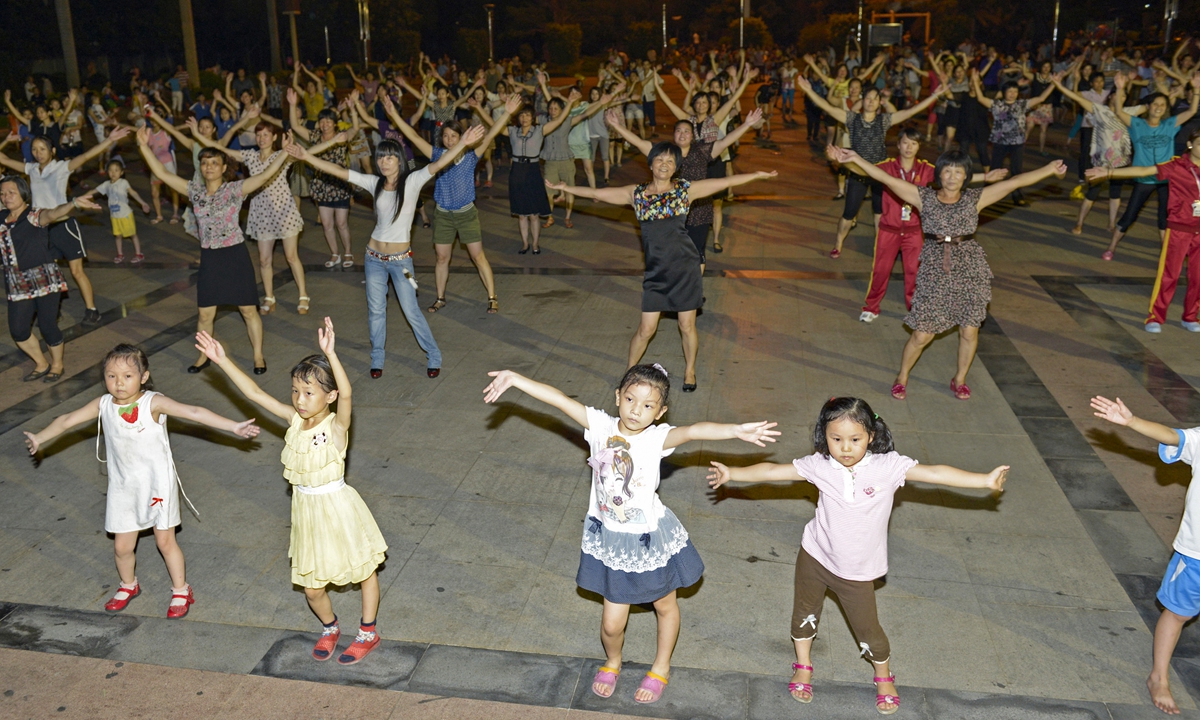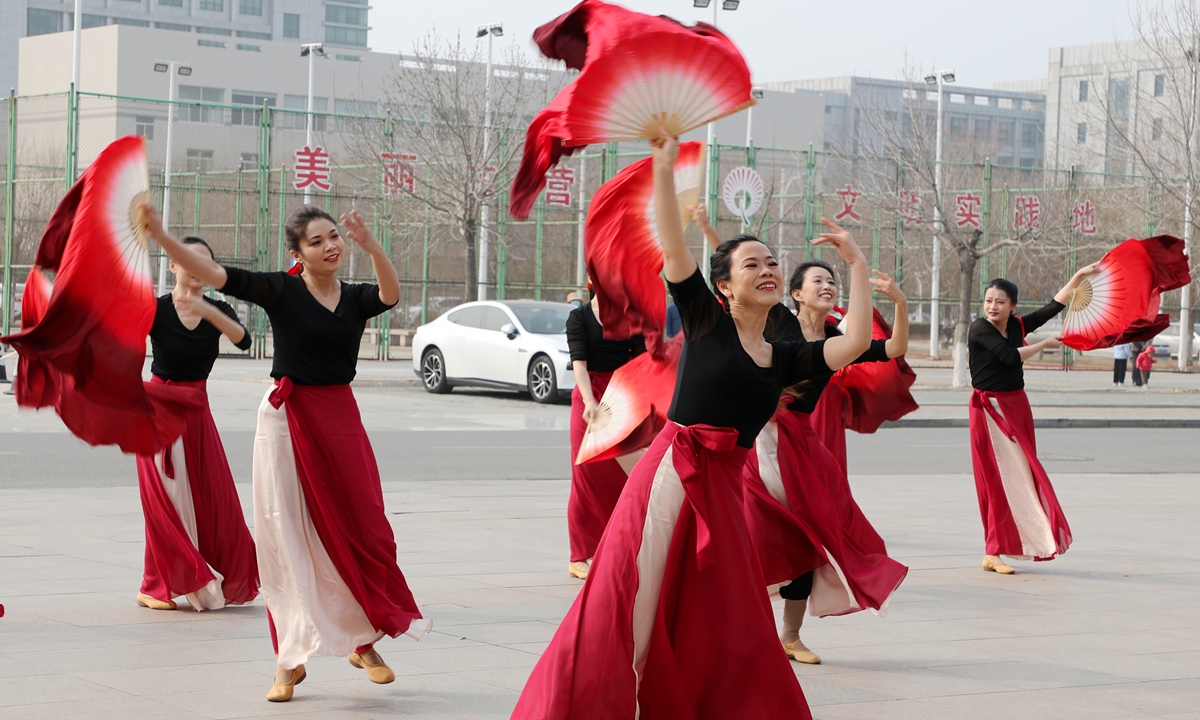ARTS / CULTURE & LEISURE
Chinese square dancing competition enhances mass leisure exercise to national level
Most popular sport

People take part in square dancing in Yantai, Shandong Province. Photo: VCG
Dressed in colorful, traditional-style costumes, groups of people of all ages dance to the dynamic music with neatly synchronized moves.These groups were participating in the National Public Square Dance competition in Beijing, the first-ever national-level square dancing competition.
"This nationally recognized event revealed the trends that have transformed this dance in today's society," Beijing-based sociologist Tang Shu told the Global Times on Tuesday.
Square dancing, or guangchangwu, is a popular form of exercise and social activity that involves groups of people, mostly the elderly, dancing to music in public squares, parks, or plazas. They spontaneously gather together, often after dinner, to join the squads and do the mostly easy-to-learn dance moves, with the aim of getting some exercise and staying healthy. For foreigners who freshly arrive in China, the self-organized square-dancing crowds in any city are a recognizable Chinese characteristic. The dance troupes range from a dozen members to more than 100.
For Tang, this conference in Beijing sent a signal: square dancing is no longer a synonym for local gatherings but something that can be looked at from the big picture, is accepted by more people and is on its way to represent the unique characteristics in China.

Dancers perform in the National Public Square Dance Competition in Beijing on June 29, 2023. Photo: Li Hao/Global Times
Folk music and hip-hopAs this form of grassroots exercise has its roots in folk dances that date back to ancient times, such as yangge and dragon dance, it incorporates elements from modern dance styles, such as ballroom dancing, salsa and hip-hop.
Today, progress is even more evolutionary: Dancers, most of whom are the middle-aged and retirees, are now dancing to K-pop and other popular forms of music, which has not only attracted the attention of youngsters, but also people from overseas.
Chinese square dancing has undergone a remarkable transformation since its inception; it's now more than just a form of exercise with simple dance moves and routines with a limited range of content.
On Douyin, the Chinese version of TikTok, videos featuring groups of square dancers performing intricate movements accompanied by popular music have garnered significant views and sparked lively discussions.
One particularly popular video showcases a group of dancers in Central China's Hunan Province performing a dance routine to the latest solo song "Flower" by Jisoo, singer and member of the popular group Blackpink.
Their synchronized performance has received applause from numerous online users.
Over in Shanghai, a group of middle-aged women were spotted dancing to the Japanese song "Gokuraku Jodo." Additionally, Chinese square dancing has also been spotted in countries such as the US, France, Russia and Austria, according to media reports.
The trend has also spread out overseas. Young Chinese Malaysian You Fuzi told the Global Times on Monday that he has been dancing with a group in a small park in Beijing for some months now.
"I picked up this hobby when I was still in Malaysia. Back there, there were groups in open spaces practicing this kind of dancing in my hometown. Do I feel embarrassed? No, I just find it fun," You said.

People take part in square dancing in Dongguan, Guangdong Province. Photo: VCG
Expanding squaresScholars have debated the origins of Chinese square dancing, with some believing it was a form of religious sacrifice.
Regardless of its roots, square dancing has become increasingly popular over the past few decades.
However, the popularity of this activity used to lead to some problems. Since dancers enjoy gathering in the early morning or at night when temperatures are cooler, their loud music has been a thorn in the side of people who live nearby and are looking to get some peace and quiet.
Some square dancing participants have taken the initiative to avoid noise pollution, such as dancing at fixed times at dedicated venues or wearing Bluetooth earphones to avoid loud music disturbing passersby.
Still, conflicts between square dancers and residents living nearby had been reported in news and social media.
Jin Fanyi, a 20-year-old college student from Henan Province in Central China, recalled how her parents used to argue with the elderly women outside their building.
"We lived in a neighborhood where there used to be a public park next to our building. I remember there were constant arguments between my parents and the grandmas outside because they were playing their music too loud," Jin said.
This situation improved when noise levels were regulated by national authorities in 2017, when the General Administration of Sport issued a notice regulating square dance activities and banned excessive noise that disrupted schools and residents' lives.
And to further combat the conflicts arising from this popular activity, measures have been implemented in some areas.
For instance, a county in Lanzhou, Northwest China's Gansu Province, issued a notice in May requiring organizers and participants of square dancing and livestreaming events to strictly control the volume of their sound systems and halt activities after 9 pm.
In Beijing's Fengtai district, a pilot program was launched on June 20 at the Songjiazhuang subway station square, where directional speakers have been installed. These systems not only play energetic songs for square dancing enthusiasts but also create quiet zones for nearby residents by bringing dancers to a specific area, fostering a harmonious coexistence between Chinese square dancing and residential life.
In addition to noise levels, competition for venues between sports enthusiasts and dancers was also an issue.
One of the solutions, as Peng Fuwei, deputy director of the Social Development Department at the National Development and Reform Commission, explained is to ensure that there is enough public space for both square dancers and people like basketball players to avoid conflict over the venues.
As a result, according to a plan developed in 2021 by the Commission and other departments, a total of 1,000 more sports parks are set to be constructed in cities across China.
The evolution of Chinese square dancing is not just reflected in park construction, regulations or innovation of dance forms. More importantly, its diversity has helped more people to embrace it, which ensures its sustainability in society today.

People take part in square dancing in Dongying, Shandong Province. Photo: VCG
Cultured form of leisureWhile the 2023 competition, under the support of China's Ministry of Culture and Tourism, may further boost the popularity of square dancing across the country this summer, the dance needs to be more than just popular. If it is to survive it must establish its own developmental paradigm.
With this in mind, the 2023 competition has made promoting the dance's variety "according to the different cultural characteristics of local regions" a major future task.
Cultural sociologist Fang Qingqiong told the Global Times that it may adopt a strategy to encourage the public, especially the elderly, to use this activity to display China's diverse indigenous cultures.
"The various kinds of performance art are always compelling. Square dancers can potentially be 'dynamic cultural inheritors,'" said Fang.
In Pingyuan county, Guangdong Province, the local intangible cultural heritage dance Luo Di Jin Qian (lit: Guangdong copper coin dance) has been adapted into a square dancing performance.
The traditional Chinese dance that has its roots in the Qing Dynasty (1644-1911) is now being carried on by not only dancers like its sixth-generation inheritor Han Meilan, but also square dancing amateur Zhong Xiuqin, a Pingyuan county local, who said the dance was "a little bit difficult, but way more interesting than popular Douyin songs."
"Introducing dance lovers to traditional culture provides a good way for square dancing to depart from its stereotypical definition of 'tasteless and brash' to become a cultured form of public leisure activity," Fang noted.
Cultivating a group of square dancers who are able to choreograph performances that are in the spirit of the times and also good exercise is another future goal. Wu Fengjun, a 42-year-old community worker in Chongqing, told the Global Times that this goal can be achieved through "mutual effort between dancers and community workers who are in charge of organizing cultural events."
Wu said that the "biggest fan base" for Chinese square dancing is still the elderly, who she noticed can often be even more "forward thinking and imaginative" when it comes to coming up with creative content.
"A lot of those dancers are also members of universities for the elderly. They pitch good ideas such as interweaving Chinese calligraphy strokes into dance formations," said Wu.
The community worker described the elderly as the "major driving force" for Chinese square dancing. Chu Xin, a cultural sociologist, told the Global Times that the elderly people's contributions are the most "essential yet important" issue for this leisure activity's future development.
Chu said that the "sense of achievement" the elderly get from participation in this dance is apparent.
"It is more than just a leisure activity, but a bridge to satisfy their need to socialize while also maintaining their mental health by giving them a performing stage," Chu noted.
